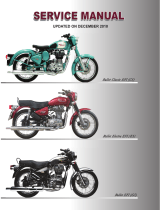Page is loading ...

45-24479
Stroker Ace Caliper Service Instructions
____________________________________________________________________________________________________
5800 W. Donges Bay Road. Mequon WI, 53092 Phone: (888) 686-3472 Fax: (262) 512-4219
www.hayesdiscbrake.com
hayestech@hayesbicycle.com
Caution: DOT 4 or DOT 3 brake fluid will strip paint. Use extreme caution to avoid getting DOT 4 or DOT 3 brake fluid
on paint. If DOT 4 or DOT 3 brake fluid comes in contact with paint, wipe it off immediately and rinse with isopropyl
alcohol.
Warning: If you get any brake fluid on the brake pads, discard them and replace with new pads. If you get any brake
fluid on the disc, clean it thoroughly with isopropyl alcohol.
Warning: DOT 4 and DOT 3 brake fluid can be an irritant when it comes into contact with human tissue. For skin
contact, brake fluid should be washed off in flowing water. For eye contact, the eye area should be irrigated with
flowing water immediately and continuously for 15 minutes. Consult with medical personnel. If effects occur from
inhaling brake fluid fumes, move to an area with fresh air. Consult a physician. If brake fluid is ingested, induce
vomiting and consult medical personnel. Used brake fluid should be disposed of in accordance with local laws.
Warning: With use, disc brake components may become very hot. Always allow components to cool before attempting
to service your bike.
Warning: When following any of the procedures below, be sure to keep your hands and fingers from getting caught in
the disc. Failure to do so could result in injury.
Warning: When you need to install any of the disc brake components, that installation work should be done by a
qualified technician with the proper tools. Improper installation could cause severe or fatal injuries.
A. Piston Removal
1. Remove the caliper from the bike by removing the two mount bolts.
2. Remove the brake pads by pulling the pads off from the pistons, and then pulling them out of
the caliper.
3. Completely remove the caliper hose assembly by removing the 4mm banjo bolt.
4. Using a 10mm Allen wrench, remove the outer caliper plugs.
5. Completely remove the outer caliper pistons by pushing it towards the center of the caliper
using Blow Plug with the extension attached. Remove Blow Plug and extension. (Fig. 2)
6. Thread in Ace caliper service bore plugs into outboard piston bores. (Fig 3)
7. Remove the inner caliper pistons with compressed air.
Warning: Wear safety glasses.
Caution: Do not grab hold of the piston post with pliers. This can destroy the piston.
8. Should only one of the inner caliper pistons release, remove bore plug tool of the
corresponding outer caliper piston, install bore plug extension and remove the remaining
piston using compressed air. (Fig. 4)
9. Carefully remove all four square seals and bore plug seals from inside the caliper.
Caution: Do not scratch the grooves in the caliper. This could cause a leak.
10. Clean all of the parts. Then rinse each part with isopropyl alcohol. Be sure to clean the caliper
through all the holes.
B. Piston Assembly
1. Begin re-assembly of the caliper by lightly lubricating the new square seals with DOT 4 or
DOT 3 brake fluid.
2. Install the four square seals and two bore plug seals by carefully pushing each seal into its
seal groove – make sure that the seals are seated squarely all the way around the seal
groove.
Note: It is important to use a new seal on the caliper bore plug each time you remove the
plug. A new seal is included in the piston kit.
3. Install the outer caliper bore plugs. Tighten to 240 +/- 12 in.-lb. (27.1 +/- 1.4 Nm)
4. Install the inner piston by sliding it through the center of the caliper and pushing it into the
caliper bore with the use of the slot-slug tool or an 8mm box wrench.
5. Repeat the previous step for the three other pistons.
6. Clean the caliper of any excess brake fluid by spraying it with isopropyl alcohol and wiping it
down with a clean cloth.
Note: Bleeders do not have to be replaced every time the caliper is rebuilt. If it is necessary to
replace the bleeder, it is available as a service kit. The thread sealant on the bleeder is there
only to seal during the bleeding process. If thread sealant wears off, replace it with a wrap of
Teflon tape thread sealant.
7. Ensure all parts of the hose connections are clean and free of any debris, and that the O-rings
are not torn or chipped.
8. Install the hose connection onto the caliper in the original position. Torque the banjo bolt to
60 +/- 5 in-lbs (6.7 +/- .5 Nm)
9. Bleed the brake according to the bleed instructions.
Note: Complete service instructions can be found at
www.hayesdiscbrake.com.
10. Center the caliper pistons by installing Slot Slug tool into caliper slot and squeezing the lever
blade. (Fig. 6) Be mindful to align the piston posts with the grooves of the Slot Slug to avoid
breaking or bending of the posts. Actuate the lever until all four pistons are equally extended.
11. Mount caliper to frame and fork and center according to the instructions in the owner’s
manual.
Note: Complete service instructions can be found at
www.hayesdiscbrake.com.
.
(Fig. 1) Contents of the Stroker Ace
Caliper Tool Kit: Blow Plug
Extension(1), Blow Plug (2), Slot Slug
(1), Banjo Plug (1), Banjo o-rings (2).
(Fig. 2) Remove the outboard caliper
pistons.
(Fig. 3) Install the Blow Plug tools
without the extension.
(Fig. 4) Blow Plug tools shown
installed with extension.
(Fig. 5) Install the caliper square
seals.
(Fig. 6) Align caliper pistons
using Slot Slug tool.
/
